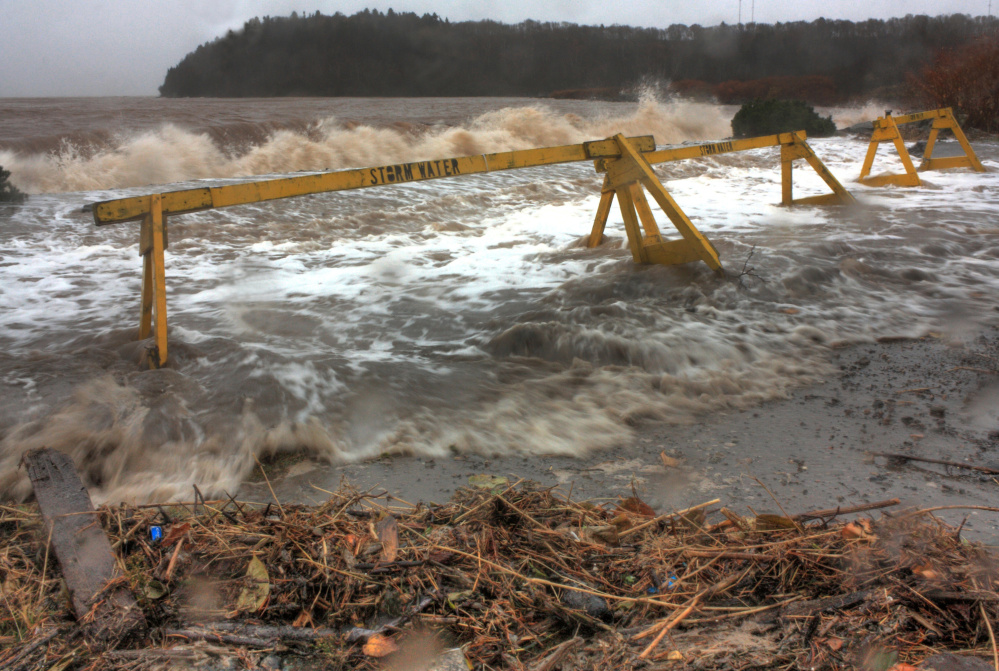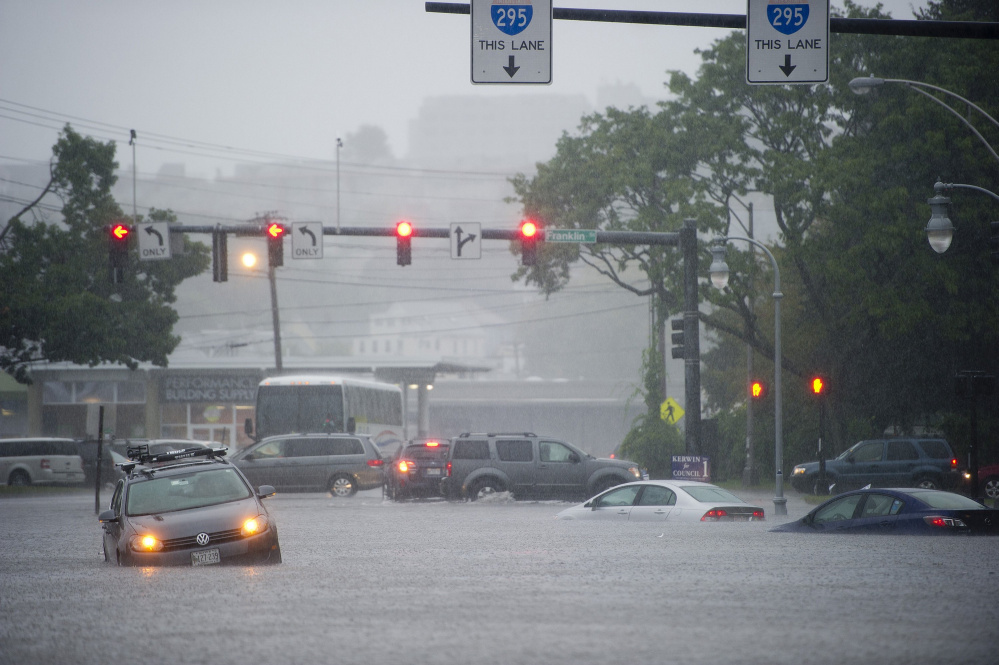From the vantage point of Maine’s rocky coast, rising seas may seem like a prospect remote in space and time. We’re conditioned to respond to felt dangers – things that go bump in the night – not chart lines, vertical datum and abstract discussions of positive feedback loops.
So we blithely continue business as usual, even as scientists steadily ratchet up the inundation levels expected in coming decades. It is, Stephen Colbert quips, a case of “sea no evil.”
Yet the water is moving in. Even for those not caught this fall in Portland’s thigh-high Bayside flood, when a deluge coincided with one of the year’s highest “king tides,” the images from that day represented a wake-up call.
More photographs circulated recently after the region’s second annual King Tides Photo Contest (disclosure: an event this columnist helps coordinate). Gale-force winds around the October king tide generated storm surge that extended the reach of high waters.
Even in calm weather, king tides are becoming problematic. When seawater first began bubbling up from storm sewers and forming briny puddles, officials called it “nuisance flooding.” Sneering at that language from “Roget’s Denial Thesaurus,” Jon Stewart put forward a few synonyms of his own – like “moisture inconvenience” or simply a “surprise pool party!”
Humor can help us contend with the sobering prognosis scientists now offer.
Among all climate impacts, write geologists Orrin Pilkey and Rob Young in “The Rising Sea,” sea-level rise “will be the most immediate, the most certain, the most widespread and the most economically visible in its effects.”
If that statement seems hyperbolic, visit the growing number of online “risk zone” map viewers, photo simulations of “global icons at risk” and websites like Boston_under_ water (see box).
In some regions, like the mid-Atlantic, the landmass is sinking even as waters rise. Maine does not suffer that added handicap, but it does have some of the world’s most rapidly warming oceans. As the Gulf of Maine warms, it expands – pushing sea levels up.
Maine also could feel the effects of changes occurring in ocean currents, renowned climatologist Dr. Michael Mann said at the recent Rising Seas Summit in Boston. A persistent “cold blob” in the ocean south of Greenland, associated with rapid glacial melting there, could further slow the Atlantic meridional overturning circulation (AMOC) – the large oceanic conveyor of which the Gulf Stream current is a part.
The AMOC began weakening around 1975, and further slowing may accelerate sea-level rise along the Eastern seaboard. When AMOC slowed markedly in 2009-2010, University of Arizona researchers noted a 4-inch spike in sea levels along the northeast coast.
The dominant driver of rising seas now is the precipitous melting of glaciers and ice sheets, which is happening far faster than climate models had predicted. As recently as 2013, the Intergovernmental Panel on Climate Change (an affiliation of thousands of scientific experts worldwide) projected that sea levels would rise up to 2.5 feet by 2100 if greenhouse gas emissions remained high.
Those were conservative numbers because gaining widespread scientific agreement forces, in Mann’s words, “lowest common denominator” conclusions. The panel chose not to factor in ice-sheet contributions because they couldn’t agree on what meltwater might add to the mix.
Due to accelerated disintegration of glaciers in Greenland and the West Antarctic Ice Sheet, both of which more than doubled their rate of ice loss in the last five years, global sea-level rise projections are now on the order of 5 to 6.5 feet by century’s end. “We’re going to get that high,” Dr. Ben Strauss of Climate Central affirmed at the Summit. “It’s a matter of when, not if.”
The West Antarctic region is the greatest scientific unknown in efforts to tabulate how fast and how much waters will rise. Scientific models tend to assume linear change, but ice sheet disintegration is exasperatingly non-linear, thwarting scientific predictions.
In May 2014, NASA researchers reported that glaciers along the Amundsen Sea are increasingly unstable and appear to be in an “irreversible state of decline.” Thwaites Glacier may be acting as a “cork in the mouth of the bottle,” Strauss noted at the Summit. Unplug that cork, and far more ice could collapse – raising sea levels 10 to 15 feet or more.
Storm surge could further magnify the devastating impacts of coastal flooding – as was evident in Hurricane Sandy when the storm tide topped 11 feet. Nor’easters are becoming more intense, and Mann reported that with the sea levels expected by late in this century, an event of that magnitude could hit every three to four years.
If we fail to slash global greenhouse gas emissions, we’ll warm the world 7 to 9 degrees Fahrenheit by century’s end, he noted: “At that point, we are looking at a completely different planet. There are no reasonable adaptations.”
Some scientists have dubbed the international climate talks that begin Monday in Paris “humanity’s last chance saloon” – the final opportunity to reset our course and prevent a world of calamitous flooding, drought, displacement and economic devastation.
Even if negotiators succeed in securing strong international agreements there, we are entering uncharted waters. We have set forces in motion that are going to reshape the face of the Earth for centuries to come.
Marina Schauffler, Ph.D., is a writer who runs Natural Choices (naturalchoices.com). She acknowledges the Metcalf Institute for Marine and Environmental Reporting that supported her participation in the Rising Seas Summit.
Send questions/comments to the editors.




Comments are no longer available on this story